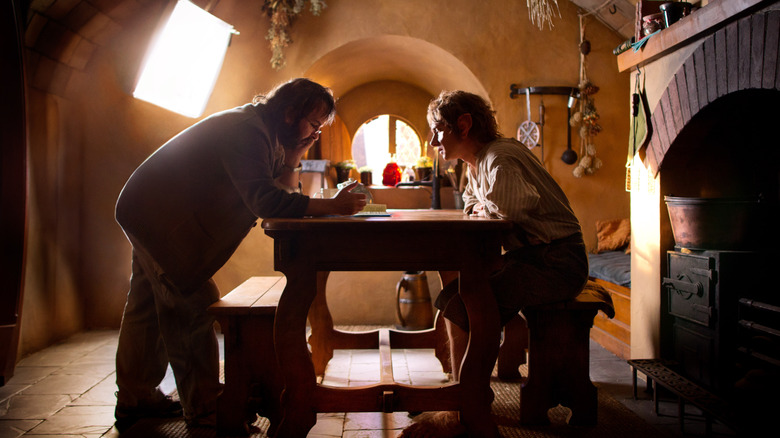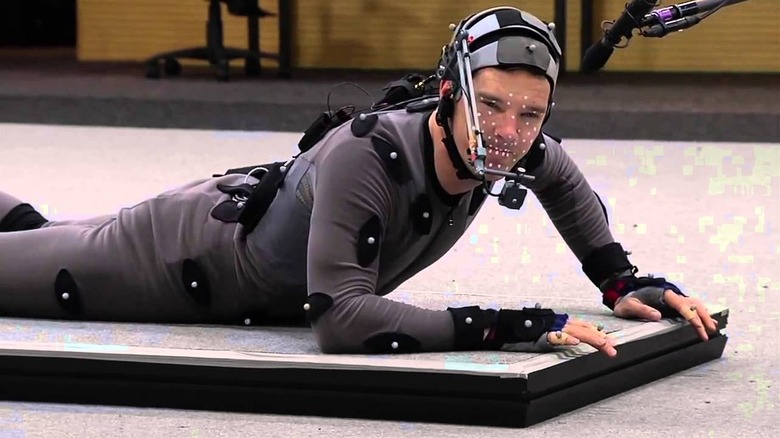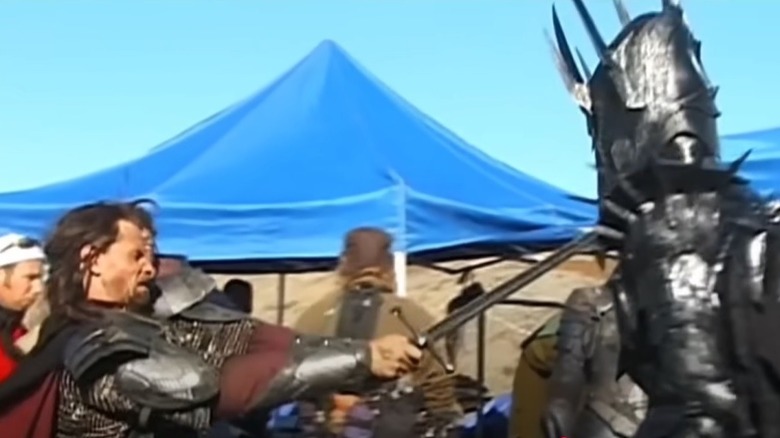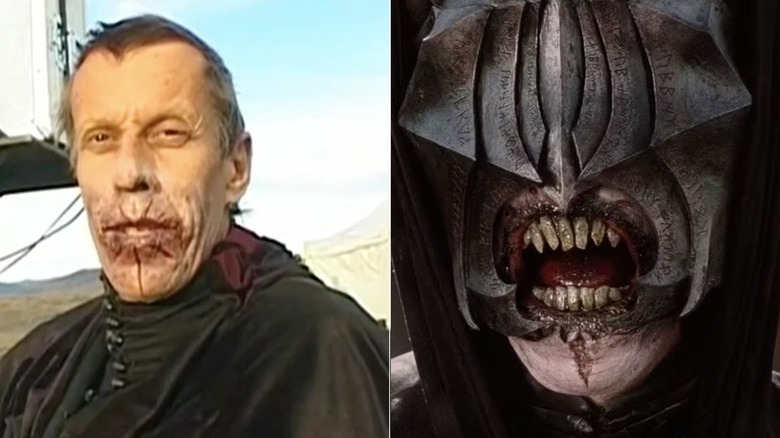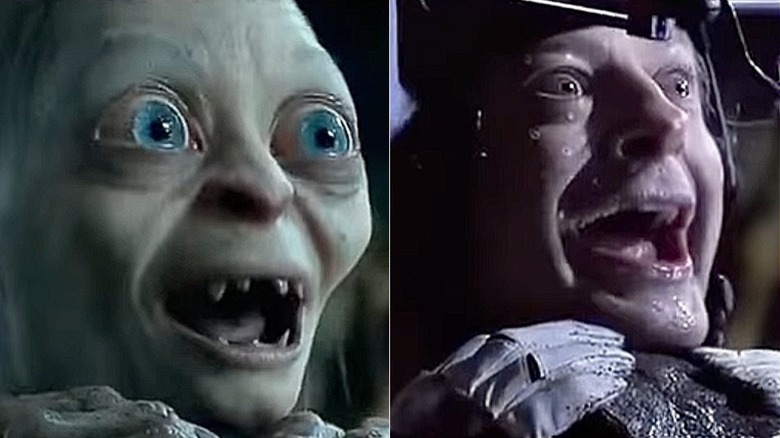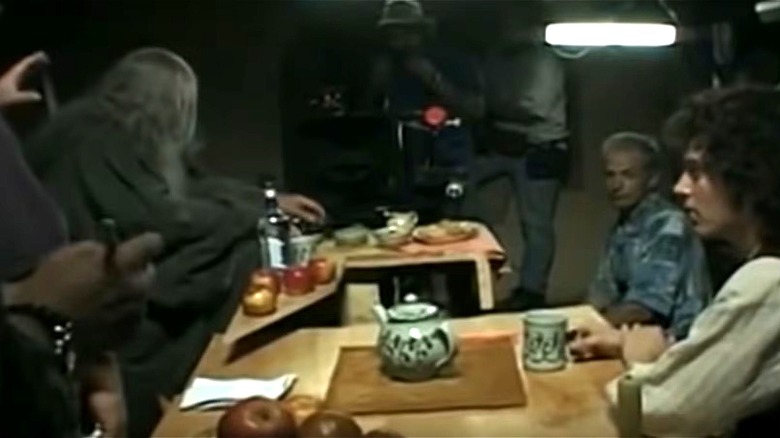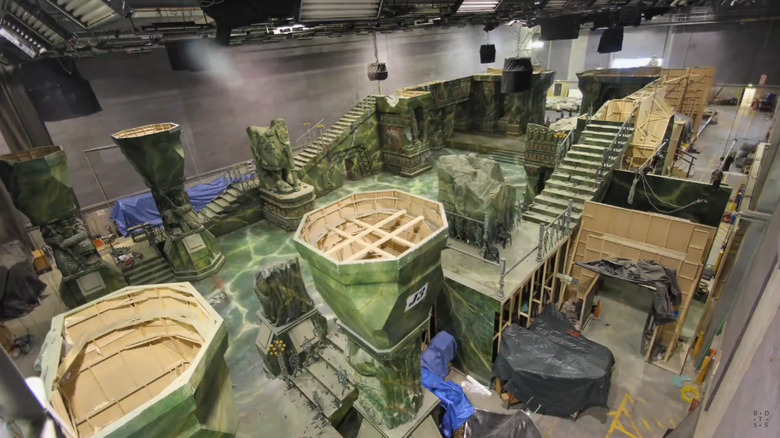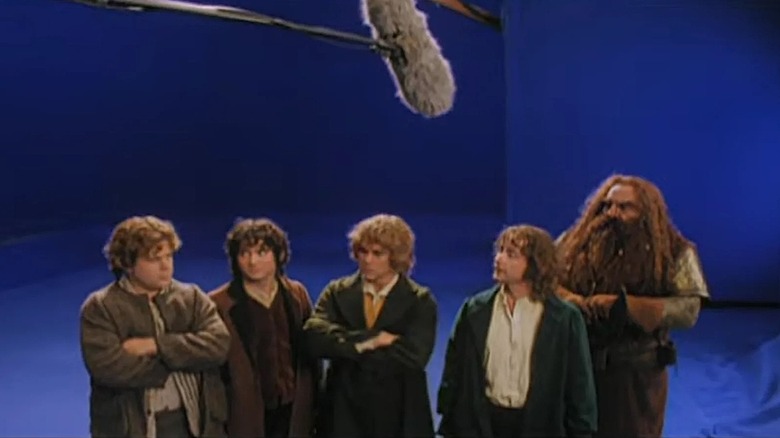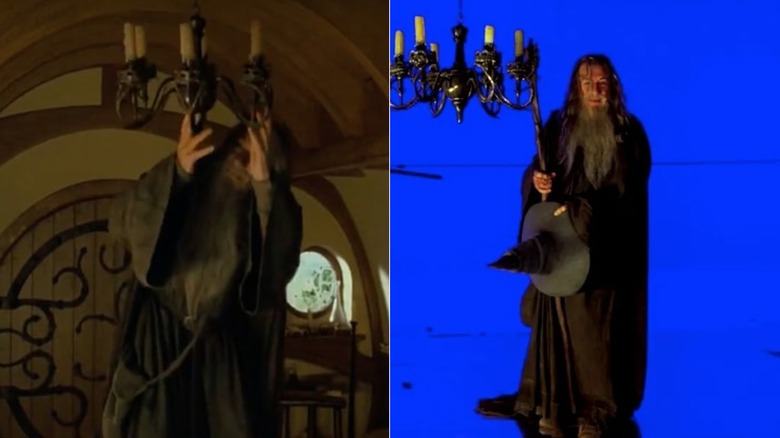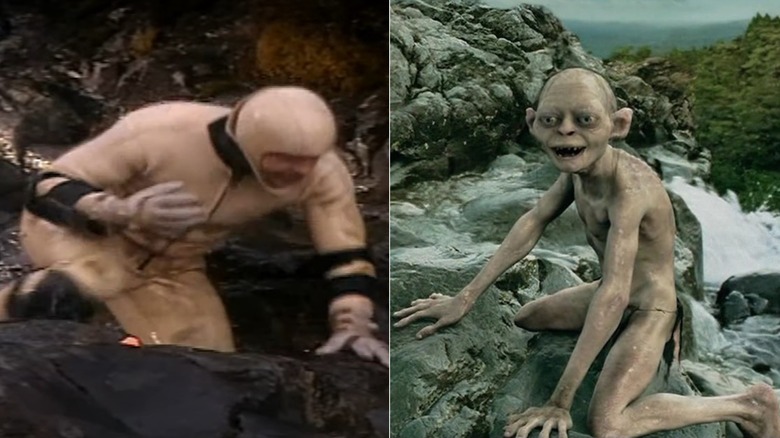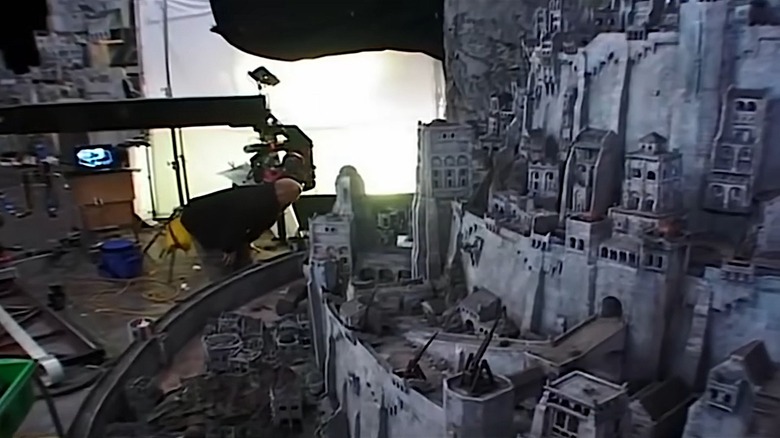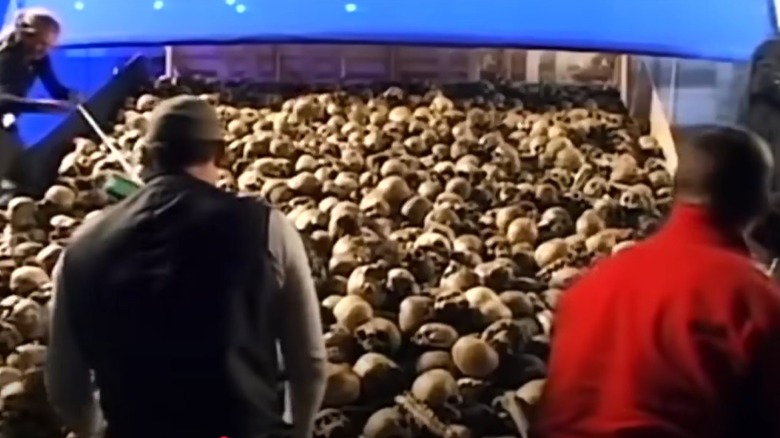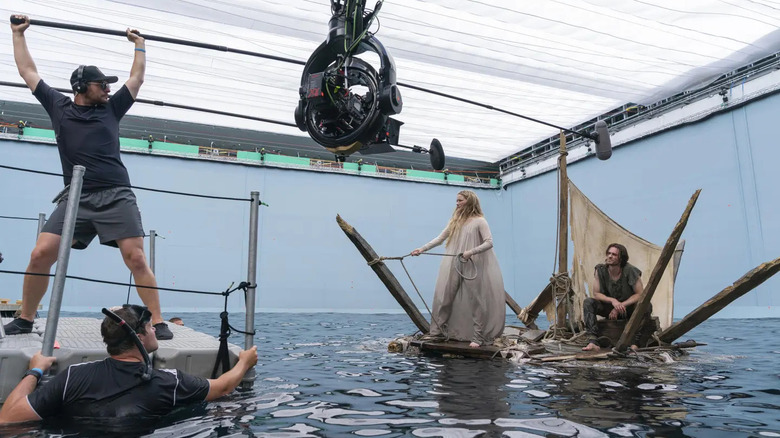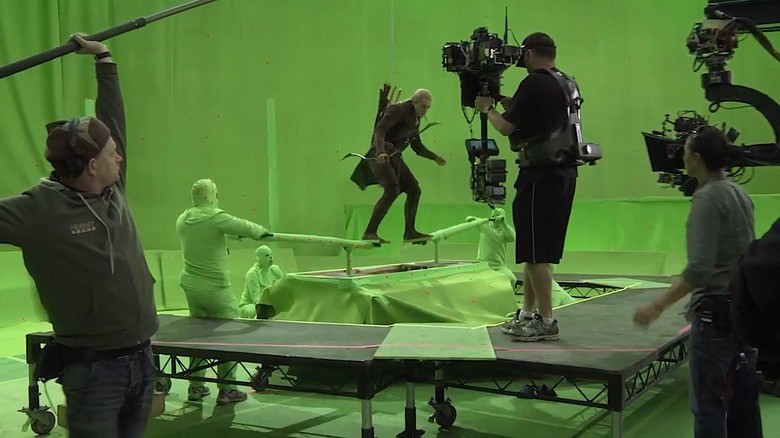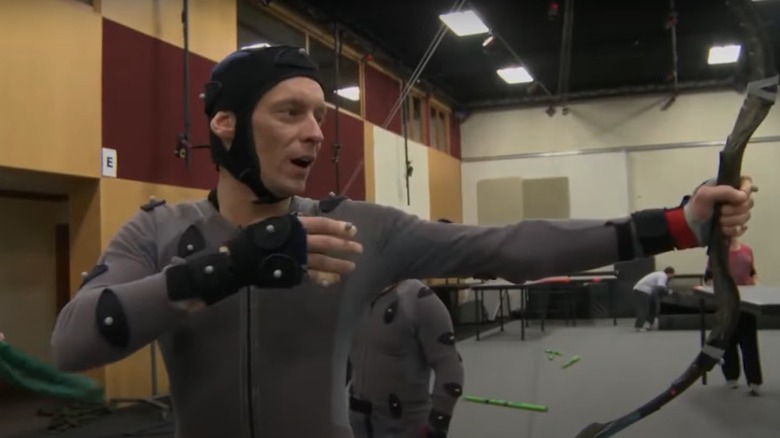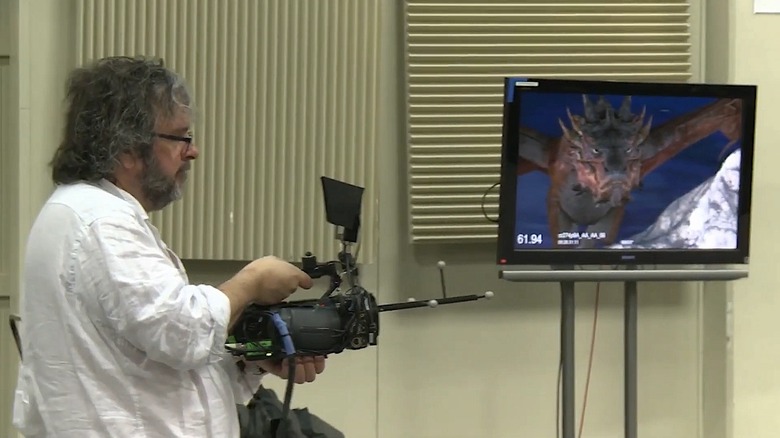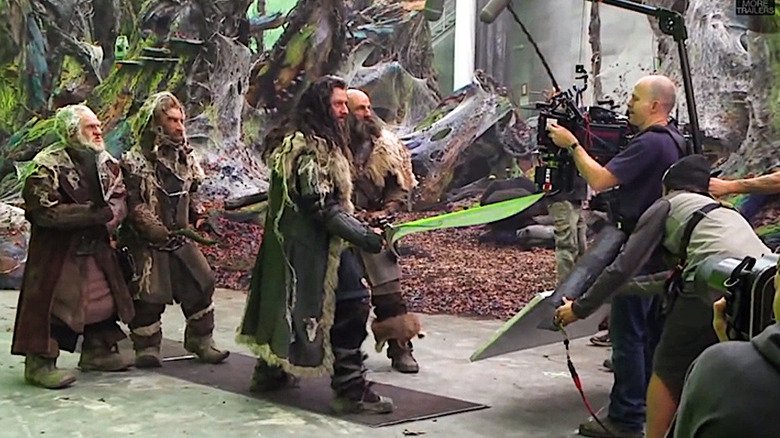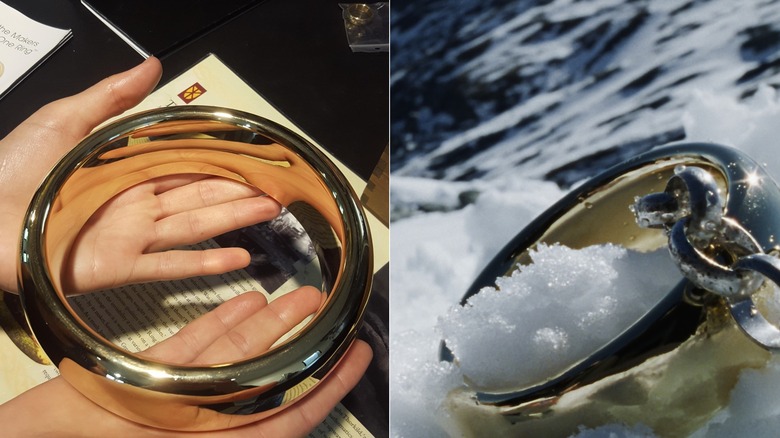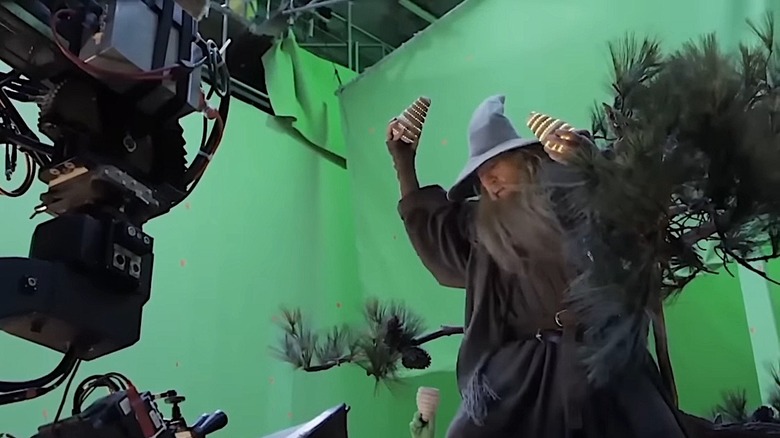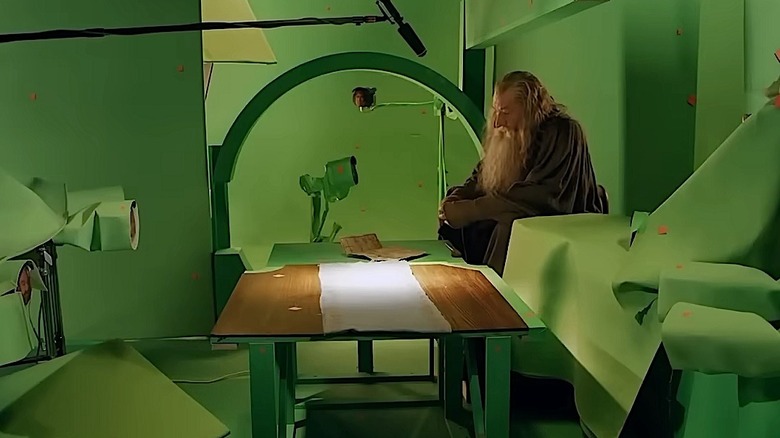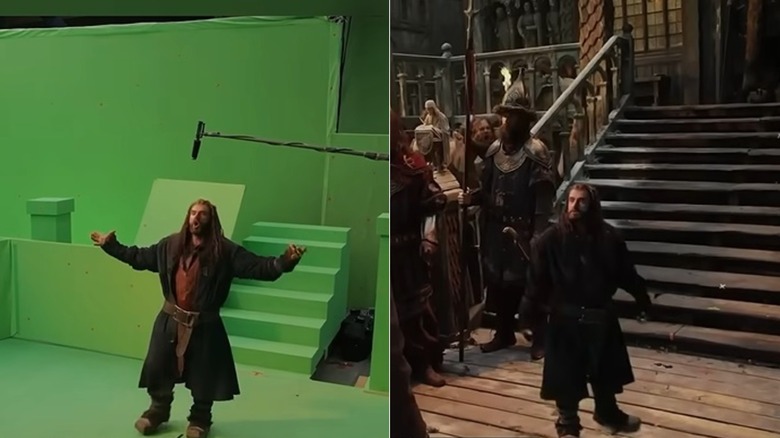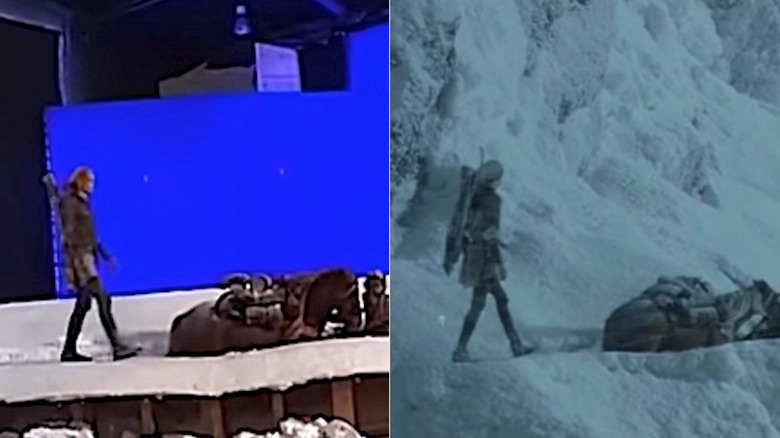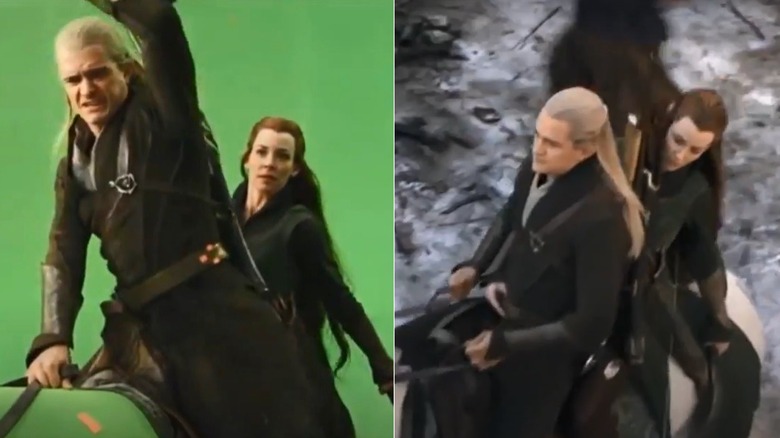What The Lord Of The Rings Franchise Looks Like Without Special Effects
Most Hollywood movies incorporate a degree of special effects these days, but some genres are more reliant on digital trickery than others. For example, it would be pretty hard to pull off a convincing fantasy film without the aid of VFX. Many successful movies in the fantasy genre have utilized a mixture of practical and digital effects, and if you need proof that this approach is a wise one, we have five words for you: "The Lord of the Rings."
Peter Jackson's indie roots came in handy when he made his "The Lord of the Rings" trilogy. The filmmaker famously used the forced perspective technique to make his actors appear a lot smaller or larger than they are in real life, which was a must in a world inhabited by Hobbits. He also had several intricate miniatures built, which look fantastic in the finished films. However, there were some things that simply could not be achieved practically, and this is where the groundbreaking work of New Zealand VFX house Weta came in.
Jackson's original trilogy set the tone for big-budget modern fantasy heading into the 21st century, and the acclaimed director returned to film the "Hobbit" trilogy a decade later. In recent years, Prime Video has channeled Middle-earth magic through its "The Rings of Power" series. Special effects are rampant throughout all of these projects — but what do they look like before they're gussied up? Let's see what the iconic franchise to rule them all looks like without special effects.
Benedict Cumberbatch was more than the voice of Smaug
Benedict Cumberbatch was a busy guy while filming the "Hobbit" movies: He voiced both Sauron as the shady Necromancer and the dragon Smaug the Golden. These two characters were brought to life with CGI, but Cumberbatch contributed more than just his voice. With Smaug, in particular, the British actor went all out, donning a motion capture suit and getting down onto his belly. Behind-the-scenes clips show Cumberbatch acting out his lines while in the suit. While it looks somewhat bizarre, the end result was one of the best moments in an otherwise middling "Hobbit" trilogy — the confrontation between Bilbo (Martin Freeman) and Smaug.
In the final version of that portion of the story, the audience is treated to an epic treasure room in the Lonely Mountain. As Bilbo (invisible thanks to the One Ring) scampers to safety, Smaug emerges from a mountain of gold and hunts around for his unseen visitor while talking to him. Seeing the dragon's gigantic motions in the movie and comparing them to Cumberbatch's own serpentine recreations on the studio floor takes the epic scene to a whole new level.
The troll that Aragorn duels was supposed to be Sauron
At the end of "The Return of the King," Aragorn leads the Armies of the West to the Black Gate of Mordor, where he challenges Sauron — only to be surrounded by the Dark Lord's armies. In that encounter, he goes toe-to-toe with a huge armored troll. However, Aragorn was originally supposed to have a dramatic duel not with a troll, but with Sauron himself.
In a behind-the-scenes featurette, director Peter Jackson revealed that they planned on having an bright white figure (meant to represent Sauron's angelic guise as Annatar) come to face Aragorn, which would then turn into a very tall, black-armored version of Sauron. Jackson ultimately decided that he wanted to focus more on Frodo and Sam as they entered Mount Doom with the One Ring, and so the Sauron part of the scene was cut.
We still see snippets of the Sauron duel in the final film, however, since they repurposed Aragorn's shots for his troll duel. The aforementioned featurette includes some low-res behind-the-scenes shots in which Viggo Mortensen swings his sword at a stunt double dressed as Sauron, prepping for a battle that would never make it to the big screen as originally intended.
The Mouth of Sauron's mouth was originally much smaller
In the extended edition of "The Return of the King," right before Aragorn duels the troll that was supposed to be Sauron, the titular character rides out to negotiate with Sauron's representative, a nameless figure fittingly called the Mouth of Sauron. Played by Bruce Spence, the character has a brief time on screen before Aragorn beheads him. But before the negotiations conclude in bloodshed, we get a few close-up shots, revealing a half-priest, half-warrior figure with a helmet that covers the top half of his face so that only his gigantic mouth is visible. The helmet is real, and Spence wore a prosthetic appliance to create split skin around his mouth.
Despite the grizzly makeup, the footage didn't wow Peter Jackson when he came to edit it. He tried digitally turning the mouth sideways (some of the creepiest body horror stuff you'll find in any Middle-earth project), but it still didn't hit the spot. In the end, he kept the mouth horizontal, but the VFX team at Weta Digital enlarged it by about 200 percent for extra creepiness. "I was really pleased with the way the effect worked because it gives you this uneasy sense that something's weird," Jackson said in a behind-the-scenes featurette. "I like it. It's one of those slightly subtle but sort of disturbing effects."
Andy Serkis really invested in Gollum's facial expressions
One of the issues with CGI characters is that, while you can use an actor for their voice and can even capture their motions, it's hard to make close-ups of their face believable. It's that lack of human expression that cranks up the uncanny valley element to eleven. This is why the "Lord of the Rings" franchise was able to make a splash by investing not just in a fully computer-generated Gollum (which was a major breakthrough in itself), but also by capturing the facial expressions of Andy Serkis in detail.
Those dots that you see on an actor's face when they are in a motion capture suit are designed to pick up the smallest elements of their facial expressions, and Peter Jackson pushed this to the limit to channel the incredible Gollum energy of Serkis. While Gollum has impressive facial expressions in both trilogies, it's "The Hobbit: An Unexpected Journey" where the technique hits its peak. In behind-the-scenes footage from the first "Hobbit" film, Serkis can be seen plastered in motion capture gear making faces that clearly made it through to the final Gollum performance.
Gandalf and Frodo's size difference is all forced perspective
Some special effects aren't created with a computer. Gandalf's arrival in the Shire during "The Fellowship of the Ring" is one of the most heartwarming and iconic moments in all of Middle-earth cinema. The scene is innocent and interesting. There's nothing unusual about it — until you watch the behind-the-scenes footage. It turns out that, to shrink Elijah Wood and help Ian McKellen stand out, the production crew had to build a unique seat on the wagon, one that helped Wood sit multiple feet further back in the contraption. Filmed at the right angle, this allowed the two actors to appear to be sitting next to one another. The end result is one of the most quietly mesmerizing uses of forced perspective in all of these larger-than-life films.
A similar contraption was made the scene in which Gandalf visits Bag End to talk with Frodo about the One Ring. In the following conversation, they retreat to the kitchen, where Frodo boils water and pours the Wizard some tea. The two characters appear to be interacting across a rectangular table and looking each other in the eye as they talk, but they're actually in different parts of the room. This is part of Peter Jackson's use of forced perspective to help shrink Hobbit actors when acting next to their larger counterparts.
In the case of the table scene, Wood is standing further away as he pretends to engage with McKellen. The table is cut into a fantastic shape and the production team even developed their own technique designed to move props like the table in the opposite direction to a moving camera shot to ensure that the visual is maintained during a motion shot. The struggle to act without making eye contact (which would also ruin the illusion) was particularly difficult, but well worth the effort.
Moria is much less impressive in real life
Wonder. Awe. Majesty. Fear. There are lots of words that you can use to describe the ancient, abandoned underground Dwarven ruins of Moria in "The Lord of the Rings." However, before the special effects were added, the set for most of the Moria scenes was pretty underwhelming.
In the above image, you can see what the effects team built for the Twenty-first Hall of the Seventh Level of Moria. This is the incredible subterranean space where all of the major action in the Dwarven mansion takes place. It's where we all look on in jaw-dropping amazement when the Fellowship of the Ring arrives in the many-pillared halls, and Gandalf risks a little more light.
The final version reveals endless rows of intricately-carved pillars holding up a distant roof. In reality, the set had a handful of half-built pillars and statues that they could use to film around over and over again for the different scenes in the heart of the abandoned Dwarven realm.
The Fellowship actually assembled in Rivendell in stages
One of the most iconic scenes from "The Lord of the Rings" is when Elrond reviews the newly formed Fellowship of the Ring as they gather for the first time to head south on their quest to destroy the One Ring. The scene comes at the end of the Council of Elrond, and seeing the heroic group gathered together with Howard Shore's score swelling in the background is one of the most moving moments in the entire story. Except, they were never actually together.
This classic shot from "The Fellowship of the Ring" is actually two different scenes filmed separately. If you watch the behind-the-scenes footage (part of which is pictured above), the shot had to be filmed using a blue screen to account for the discrepancies in the Hobbit-sized and Dwarf-sized actors. This led to a two-shot iteration that was combined, with one version shrunken down, showing the four Hobbits and Gimli looking smaller, and the other depicting the full-size Aragorn, Gandalf, Legolas, and Boromir behind them.
Gandalf's size made multiple Bag End scenes tricky
Wizards aren't necessarily big folk to the average Man or Elf. To a Hobbit, though, they're huge. This created a challenge when Peter Jackson had to film Gandalf paying multiple visits to the Hobbit-sized Bag End. This happens early in "The Fellowship of the Ring" when Mithrandir (another of Gandalf's many names) shows up for Bilbo's 111th birthday party. He comes back again later to talk to Frodo and send him on his quest. Throughout these two encounters, we see him enter through the round Hobbit door, walk through multiple rooms, sit down in the kitchen, converse in the parlor, and famously hit his head against a lintel. Each shot came with its challenges, and forced perspective trickery was used in some instances, but the task of scaling Ian McKellen to an appropriate size in the Baggins residence took more than a custom-made kitchen table and some carefully chosen lines of sight.
When Gandalf enters Bag End, multiple versions were shot to accommodate the size difference between himself and a Hobbit-sized Ian Holm. A smaller person in costume was brought in for one shot involving Bilbo, while in another shot, McKellen is filmed with a blue screen and passes his hat and staff to a crew member. The two shots had to be digitally combined to get the full effect. Elsewhere, McKellen was hoisted on platforms to give him a taller, more imposing appearance and generally positioned to be closer to the camera, making him bigger in each shot. It all comes together brilliantly in the finished film, which gives no hint at all the effort that went into making the Bag End scenes.
Andy Serkis was really in that river in The Two Towers
"The Lord of the Rings" wouldn't have been the same without the incredible motion capture work of Andy Serkis, but what's even more impressive is that he had to film many of his scenes twice. For the most part, capturing Gollum's performance took two sets of takes: After filming with the other actors, he would re-perform each part on a motion capture stage. Doing this in a contained studio space creates stable conditions, which makes it much easier to get motion capture to work properly. Combining the footage creates a more believable end result.
It's safe to assume that Serkis preferred shooting on a studio stage rather than on location, because he had to contend with some very challenging conditions. In one instance, the crew arrived at a location to film the scene where Gollum tries to go fishing with his bare hands in a shallow stream. In the final version, a CGI version of Sméagol splashes through the water, wrestling with a slippery fish for several yards before he loses it. Serkis himself was in that stream, and the water was nigh-on freezing.
The craziest part is that when the crew arrived on set, it wasn't a warm day like in the movie — it had been snowing. They spent hours melting the snow in the immediate area just to clear enough space to film the sequence. Serkis donned some thermals and jumped into the cold water to get the shot, which is a testament to his dedication. Sometimes, acting takes genuine sacrifice, and it's even more admirable when the actor in question won't even be seen in the final film.
The sets were often built in miniature (but were still massive)
One of the most impressive elements of the "Lord of the Rings" films is the sets. Many of these are enhanced by CGI, but usually, they are at least partially built in real life. The crew invested countless hours into building miniature sets that were still massive despite their shrunken size. The biggest of these was a Minas Tirith replica (pictured above), made at a 122:1 scale. Despite scaling things down, the build was still a robust 23 feet tall and 21 feet in diameter, making it an imposing structure all on its own. The level of detail was astounding, too, with over a thousand handmade houses located across it. And this isn't the only Minas Tirith replica: Portions of the Tower of Guard were built at a 14:1 scale as well, right down to the tiniest details, to give a more life-like appearance to those zoomed-in shots.
According to Weta Workshop founder and creative director Richard Taylor, 72 miniatures were created for the original trilogy. Another impressive miniature was made for Helm's Deep. When it was finished, it was over 16 feet tall, 32 feet wide, and nearly 40 feet deep. Construction on the scaled miniature began three and a half years before filming began, back when Miramax was developing the Tolkien adaptation. When production hit a snag, Taylor was ordered to chainsaw the miniature into pieces and put it into storage. Weta delayed taking such a drastic step and, at the last minute, the project was saved by New Line Cinema, so the impressive miniature was preserved for the shoot.
80,000 miniature skulls were created for the original Army of the Dead scene
Aragorn's recruitment of the Army of the Dead is a lot more in-depth in the extended version "The Return of the King." It ends with a huge pile of skulls bursting out of the wall and apparently trying to kill Aragorn and Gimli (Legolas is fine, thanks to his light-footed Elven physiology). The pair push through the torrent of skulls, and the trio emerge outside the mountains, where the story proceeds. However, creating that subterranean exit was a massive task. The sequence at the City of the Dead features a cliff-face necropolis inspired by Petra in Jordan. When the walls of this already impressive edifice crack open, releasing the torrent of human skulls, the practical and CGI effects kick into full gear.
To create this, Peter Jackson first filmed Aragorn and Gimli in real time on a smaller set with a bunch of life-sized skulls. The backdrop is a blue screen, which makes it possible to layer this with a second shot created using a scaled-down model and smaller skull recreations. How many skulls? The prop crew started with 200, but quickly realized it was nowhere near enough. They kept making more, finally settling for around 80,000 mini skulls in total. Layered over the real-life shot with the actors, the massiveness of the effect is eerie, awe-inspiring, and mesmerizing. It's a shame it never made the theatrical cut of the film, but, frankly, it's excision is understandable — it's one of the worst scenes added into the "Lord of the Rings" extended editions.
The Rings of Power went sailing in a boxed-off sea
When Prime Video announced that it would be creating a series that focused on Second Age Middle-earth, one of the first bits of production news centered on the creation of a gigantic water tank on its New Zealand set. This ended up being central to the first season of the show, as multiple scenes took place in Belegaer (the giant body of water along the left edge of the Middle-earth map), aka the Sundering Seas. One of these scenes featured a storm, which made for some particularly tricky filming.
While these sequences appear expansive on the screen, they were actually filmed in what amounted to an oversized swimming pool. The water tank the studio built to film in allowed the team to capture about 50% of their final product through practical effects, with the other 50% coming through digital effects. The picture above shows what the scene and background looked like before the VFX and other computer-generated elements were added to the mix.
According to visual effects supervisor Ron Ames, blending the real water with the fake water was tricky for the team at Industrial Light & Magic, one of several VFX houses that worked on the show. "The seams, that's the hardest thing to do, where the practical water meets the visual effects water," Ames told Collider. "Where the visual effects come in are the large waves that obviously we couldn't generate in a tank."
Legolas chased barrels on a green screen seesaw
One of the most memorable moments in J.R.R. Tolkien's "The Hobbit" is when Bilbo helps the Dwarves escape the dungeons of the Wood-elves by packing them into barrels that are shipped down a nearby river, right to the doorstep of the Lonely Mountain. When Peter Jackson adapted the scene, he chose to spruce it up a bit — and by that, we mean he turned it into a ridiculously dramatic chase sequence. The Dwarves are openly visible in their leaky tubs. Orcs are chasing, shooting at, and inevitably failing to capture them. Legolas, Tauriel, and the Elves are also scrambling around the edges of the excessively violent river, killing their enemies, using the Dwarven heads as stepping stones and trying to keep tabs on them.
The barrel chase sequence is wild enough with the digital effects added in. Take them out, though, and it just looks straight-up insane. The picture above shows Legolas actor Orlando Bloom filming in a completely green set as green-clad crew members operate around him. In other shots, he jumps off obstacles and recreates each scene to a degree. Legolas' antics in the barrel shots are so outlandish in their Elvish physical accomplishments that it took multiple green-screen sets, gimbals, seesaws, and wire setups to get everything they needed.
Legolas was partially played by a guy called Allan Smith for some action scenes in the Hobbit trilogy
We've seen a lot of Andy Serkis in motion capture suits for Gollum. Benedict Cumberbatch played his character in motion capture gear, as well. But there were points in the creation of the "Hobbit" trilogy where people had to don motion capture suits to play characters they didn't even appear as on screen. One example is the fully green-screen shots of Legolas during the barrels sequence in "The Hobbit: The Desolation of Smaug." In that sequence, Orlando Bloom didn't do all of the filming. There were multiple points where they had to use a fully CGI version of the character to pull off some crazy Elf-like stunt. In those cases, they brought in Bloom's stunt double, Allan Smith.
Smith would put on the all-too-familiar dot-covered gear to capture shots of Legolas firing off arrows and taking out Orcs, and these were sprinkled throughout the scene. For the creative crew, this was a great way to get what they needed at a high quality. It was so effective that Animation Supervisor Eric Reynolds even said, "If we can't get Orlando Bloom, we really do have the next best thing on the planet to help us through with these motions of what Legolas would do or how he would act." The goal was to deliver on Peter Jackson's vision of trying to make even the full CGI scenes feel like they could have been filmed in real life. The final results are questionable, but the attempt was an admirable one.
Peter Jackson filmed nothing to capture Smaug's chase
The ending of "The Hobbit: The Desolation of Smaug" has a lot of computer generated imagery. We've covered the way the filmmakers captured the specific behaviors of the Golden Dragon through Benedict Cumberbatch's slithering motions, but the big chase scene with Smaug going after the Dwarves was filmed by Peter Jackson — and when we say "filmed," we mean he actually walked around a gigantic performance capture stage with a camera filming, well, nothing. The director wasn't trying to capture actors on a blue screen or a specific set.
"We worked through the whole process," Animation Supervisor Eric Reynolds said. "Where the Dwarves are at, how the Dwarves put the water on him, freak him out, the whole gold thing — all that was blocked out in big chunks." Reynolds compared it to wearing virtual reality goggles — Jackson could see the scene playing out through his camera, and he would move around to get the angles that he wanted. "It was ultimately a way in which I could get into the middle of a digital world with a camera myself," the director explained. The result was a larger-than-life chase through the halls of a Dwarven mansion that the practical effects team didn't have to build in advance.
Green swords and hair make a difference
Sometimes, even the most simple things need to be spruced up to fit the fantastical world of J.R.R. Tolkien. Small details like pointy ears, for example, make all the difference when it comes to making the viewer feel as though they really are in Middle-earth. This makes filming certain scenes tricky, as you can't just think about the big, splashy CGI. You need to consider those little aspects that give the finished product a more professional, fully immersive feel.
One shot that encapsulates this concept was taken while filming the Mirkwood sequences in "The Hobbit: The Desolation of Smaug." It depicts Thorin and three of his Dwarven companions. While the actors were in their costumes on set, portions of their equipment was not the right color: It was green, and you know what that means. From splotches of green web in their hair (hello spiders!) to Thorin's sword blade (which glows blue when Orcs are near), the need to green-screen even little bits of the actor's ensembles can create a distinct difference between the raw and the final footage.
A gigantic One Ring helped drive home its importance in certain scenes
Peter Jackson's employment of forced perspective extended to props, too — most notably, the One Ring. While life-size versions were cast for the actors to use in regular scenes, there was also a gigantic version of the Ring. Placed the right distance from the camera, this created a more magnified and dramatic shot for close-ups. It was easier to capture reflections and give the One Ring a bigger presence on the screen.
One example of this being done was the shot of the One Ring falling off Frodo's neck in the snow. It is shown briefly sitting on the icy ground with members of The Fellowship off in the distance before Boromir picks up a normal-sized version, looks at it closely, and hands it back to Frodo. The giant prop was later used for the scene in which Sméagol and his friend Déagol fight over the freshly discovered ring, leading to the latter's death and the start of Sméagol's transformation into Gollum.
The truth about Gandalf's flaming pinecones
Some scenes in the "Hobbit" trilogy are so big that it's hard to figure out what, if anything, is real. Sometimes the answer is barely anything. For instance, when Bilbo, Gandalf, and the Dwarves escape from the Misty Mountains and are cornered by wolves and orcs, there is fire, flashing swords, and action all over the place. There are also lots of trees — an entire forest surrounds them as the Dwarves and Bilbo huddle on tree branches, with Gandalf magically firing up pinecones to throw down at his adversaries.
In reality, the set where Ian McKellen filmed his scenes was full of green screen walls and a single tree top. The actor climbed up into the fake broken pinetree, grabbed some glowing tan props, and pretended to throw them down into the midst of his imaginary foes below. Not ideal conditions for acting, you say? McKellen would likely agree. The actor was frustrated while filming the scene as he attempted to imagine the grandiose story going on around him with little to go on but a few twigs and some pinecone-shaped baubles.
The Bag End scenes in The Hobbit broke Ian McKellen
For the Bag End scenes in "The Fellowship of the Ring," Ian McKellen had to deal with forced perspective angles and uncomfortable lines of sight with his fellow actors. It was tough, but he still had fellow professionals to work with and real-time lines to react to. McKellen's experience when he returned to reprise his role as Gandalf in the "Hobbit" franchise was downright awful by comparison. As the only Wizard in a room full of Dwarves and a Hobbit, McKellen often had to film his scenes alone to avoid size discrepancies. Sometimes, this left him with awkward shots, like the pinecone and tree scenario. At other times, it left him utterly isolated, with nothing but green in sight.
One shot sees Gandalf interacting with the Dwarves and Bilbo gathered around the latter's table. McKellen had to film the scene alone in a green-screened version of the Bag End interior. Everything from cameras to the walls and even portions of the table are wrapped in green. In a behind-the-scenes featurette, Peter Jackson explained that they felt bad leaving McKellen "dumped in green screen land." Things were bad enough that it drove the actor to tears. McKellen said of the experience, "I got absolutely miserable and had a little cry to myself." He added, "It was so distressing and off-putting and difficult that I thought, 'I don't want to make this film if it's what I'm going to have to do.' It's not what I do for a living. I act with other people. I don't act on my own."
Thorin's rousing speech was to nobody
Like Ian McKellen's struggles with on-set isolation in the "Hobbit" movies, there is another moment in that trilogy that drives home just how much of a green screen fest it was. In "The Hobbit: The Desolation of Smaug," the Dwarven leader Thorin Oakenshield (Richard Armitage) has to give a rousing speech to the Men of Lake-town. The scene involves Thorin's company of 13 Dwarves and a large crowd of 200 or so Lake-men. To achieve the right perspective, things were broken up, with the standing crowd filmed on set and the Dwarven bits captured in a green screen room.
Armitage remembered the challenge of giving a rallying speech to no one, even though he was supposed to be making eye contact with the larger Humans. He specifically recalled McKellen's troubles as a reference point in his preparation, saying, "I remember being very aware of what Ian had gone through in Bag End." He added that his solution was to rehearse extensively. "We'd go back to the main set, rehearse the scene, and I would try and program all of the faces that I'd seen into my head and then go back to the empty set and try and bring back the memory of all those people."
How Legolas walked on snow
One of the best moments in "The Fellowship of the Ring" is when the Fellowship is trying to scale the mountain pass of Caradhras in a growing snowstorm. Everyone struggles in the deep snow except for one person: Legolas. This comes directly from the book of the same name, where Tolkien wrote that Legolas sprang nimbly over the snow, adding that Frodo notices "that the Elf had no boots, but wore only light shoes, as he always did, and his feet made little imprint in the snow."
Orlando Bloom channels that light Elven wonder in the movie by walking alongside the Fellowship as they wrestle with the frozen, waste-high blockage. While Bloom is in some of the shots, at other points extras were used against a blue screen and a solid faux-snow set. A deep pathway was created for the actors playing the non-Elven characters to battle through, while the raised edges were solid, allowing Bloom and/or doubles to walk beside the rest of the Fellowship while seemingly not impacting the snow.
The BTS Legolas and Tauriel clip that went viral
Legolas and Tauriel ride a horse through a battle together in the "Hobbit" trilogy, and there are clear points in that chase where CGI is used. Not only are there goblins all around them, but both the Elves and their steed are performing borderline impossible actions as they ride up hills, over broken paths, and through a sea of swords and spears. To achieve this shot, Orlando Bloom and Evangeline Lilly spent time filming a sequence in the studio on what can only be called a green blob in yet another green screen room (they were a dime a dozen with the "Hobbit" films).
In this case, the experience felt more like riding a mechanical bull than anything else. As they attempted to act out the scene, they pretended to fight imaginary enemies, with Bloom focused on leading the horse through the melee and Tauriel shooting arrows at everything that moved (in her imagination, of course). The funny part was having both actors on the machine at the same time, moving in rhythm. Lilly said that when they went to film the scene, "We were told to sort of exaggerate the horse riding movements." This led to a comically suggestive take that gave everyone a good laugh, including the actors themselves. The behind-the-scenes footage went viral, and is arguably more fun to watch than the finished scene.
